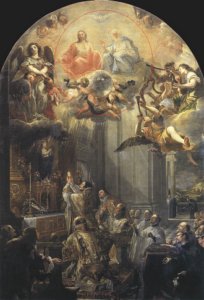
Arquivo para a ‘Método e Verdade Científica’ Categoria
What humanism are we talking about
It is common to establish a connection between ontology studies and the question of existence, the philosopher Paul Sartre did, but neither the ontological tradition of scholasticism nor Heidegger make this connection, the latter emphasized: “The main statement of existentialism has nothing in common with that statement of Being and time” (HEIDEGGER, 1996, p. 329).
studies and the question of existence, the philosopher Paul Sartre did, but neither the ontological tradition of scholasticism nor Heidegger make this connection, the latter emphasized: “The main statement of existentialism has nothing in common with that statement of Being and time” (HEIDEGGER, 1996, p. 329).
In his 1947 Letter on Humanism, Heidegger states that what distinguishes man is his relationship with being and the way in which he protects being, and not insofar as he is defined as a being endowed with reason, he himself criticizes humanism, for him what there is is a forgetting of being, which is diagnosed in every western philosophical tradition, starting with Plato and extending to Nietzsche.
The theme of being characterized in Western thought, which has incipient roots in the pre-Socratics, since it predates “episteme”, is again taken up from Heidegger as a “fundamental ontology”, that is, with the possibility of questioning the be, and like this questioning, the humanism of every man.
It is necessary, while discussing ontology, to understand that Dasein, Heidegger’s being-there, is concerned with examining how the first, the original understanding of man in his very essence, takes place, even before the moment of formulating a theory or of having consciousness, theory arrives at a later time and consciousness gives after man’s opening to Being.
To understand what Heidegger characterizes as existence, one can read: What is metaphysics? (1929), which reads: “The word existence designates a way of being and, without a doubt, of the being of that being that is open to the opening of being, in which it is located, while sustaining it” (Heidegger, 1989, p .59).
Thus, the objective of the fundamental ontology of Being and Time is the being who is placed as a privileged being and who is able to question the being, who has an understanding of being [Seinsverständni], and this being is man, and from him what thought humanism.
It is true that there is a criticism of Peter Sloterdijk in “Rules for the human park: a response to letters about humanism”, which questions anthropocentrism, our relationship with nature.
Heidegger, M. (1989). Ser e Tempo Translation by Márcia de Sá Cavalcanti. Petropolis: Voices.
______. (1989) What is metaphysics? Translation by Ernildo Stein. São Paulo: Abril Cultural. (Os Pensadores collection).
The narrative and its contexts
The emergence of studies for analysis in non-positivist and interpretive methodologies in the human sciences has given rise to a crisis of knowledge (episteme) in the cultural panorama of our time that has attracted several scholars to the subject, including: “the forms and genres of narrative, especially, they have attracted attention (Bamberg 1997; LP Hinchman & SK Hinchman 1997; Polkinghorne 1987).
interpretive methodologies in the human sciences has given rise to a crisis of knowledge (episteme) in the cultural panorama of our time that has attracted several scholars to the subject, including: “the forms and genres of narrative, especially, they have attracted attention (Bamberg 1997; LP Hinchman & SK Hinchman 1997; Polkinghorne 1987).
Bamber explores the three decades of narrative analysis, Hinchman and Hinchman organize a collection to discuss problems of identity and memory in communities, and Polkinghorne studies knowledge as narrative in the human sciences. from the most general to the most specific.
However, from a historical point of view, the theme is very old and can be analyzed in Aristotle’s Rhetoric, and more contemporarily there is a long tradition of these studies in literary theory and linguistics.
There is a recognized difficulty in defining the narrative, firstly because of the forms and styles that are quite varied, and thus its cultural phenomenology is not only diverse but open, and, secondly, there are structural elements in the narratives that are present in other types of discourses with legal, scientific, historical or religious texts.
I highlight the studies of Paul Ricoeur, in his classic Time and Historical Narrative (1981-1983), where the philosophical reflection is precisely in the relationship between “time lived” and “narrative”, which, more profoundly said, means “experience” and “consciousness ” which makes the concept in closer contact with the contemporary philosophy where time, experience are in connection.
It confronts the concept of structuralizing historiography since 1945 and the mid-1970s, and displaces the historian’s discourse to belong above all to the order of narratives, albeit a special type of narrative that is not analytical.
His analysis makes a dialogue with the work Confessions by Augustine and Poetics by Aristotle.
His phrase “all history is narrative”, is not just contempt for the mere relation to the factual, or the biographical, not even the agitated situation of political history, his intention is to give meaning to the lived, sensitivity and human action to a historiography that seems to abstract from man.
What Paul Ricoeur highlights in his “narrative” as “Master History of Life”, which is beyond the great statesmen and politicians, and available to the human being whose daily experience challenges him.
References:
Bamberg, M. (Org.) (1997). Oral versions of personal experience: Three decades of narrative analysis. Journal of Narrative and Life History, 7, 1-4.
Hinchman, L. P. & Hinchman, S. K. (Orgs.) (1997). Memory, identity, community: The idea of narrative in the human sciences Albany, NY: State University of New York Press.
Polkinghorne, D. (1987). Narrative knowing and the human sciences Albany, NY: SUNY Press.
RICOEUR, Paul. (1994) Tempo e Narrativa Tomo I. Campinas. Papirus.
Action without reflection, the “active” life
When criticizing the “Society of tiredness”, the efficientism that Byung Chul Han takes up in his last book, in the following post we will comment, both point the finger at activism, or the word that Sloterdijk likes: “agitationism”.
Byung Chul Han takes up in his last book, in the following post we will comment, both point the finger at activism, or the word that Sloterdijk likes: “agitationism”.
The notion of praxis that Sloterdijk defends is not the notion of praxis as an act that considers the central myth of modernity – “agitationism”, which is, at bottom, just an inversion of poesis and theory – but as a “letting go -flow”, a type of active contemplation.
To demystify this notion of praxis as a necessary correlate of action-reason, practical philosophy would have to become aware that it allowed itself to be deluded by the myth of action and that its alliance with constructivism and activism prevented it from realizing that the The highest concept of behavior is not action, but letting it happen, being able to let go of the things that pass you by and act through you, in order to be more faithful to the author’s words.
To understand what he means by Critique of Cynic Reason, one of his most hermetic works, he differentiates classical from modern cynicism, which comes from the origin of the guild term “kŷőn”, from modern cynicism that has become an “enlightened false consciousness”.
The Enlightenment assumed that one lived in darkness where evil was practiced, but that this evil would be the result of ignorance, so its attempt to illuminate those lacking the light of reason, but this created a “false consciousness”, a distorted view of reality,
The Enlightenment presupposed darkness where evil was practiced, which was seen as the fruit of ignorance. Criticism tried to illuminate the dens devoid of the light of reason. Hence the basic concept of ideology as “false consciousness”, as a distorted and therefore false view of reality, and so that you don’t think that this is just philosophy, the “engaged” thinker Slovoj Zizek will also say that it is inscribed in the things themselves.
In a different way, Husserl, from whom all the affiliation of modern phenomenology is heir, also proposed, to return to consciousness of the things themselves.
Modern cynicism has also become a form of ideology in which a mask continues to turn into action, building grand theories that both “figuratively” and “in the literal sense act as if they don’t know or don’t know reality, everything is narrative only to use the current word.
Hence the critique of cynical reason defending a critical-ideological-classical procedure that has become obsolete, and this critique now contrasts a lightness of humor with the excess of theory.
The author will say: “[…] The great thought of antiquity has its roots in the experience of enthusiastic serenity, when, at the height of having thought, the thinker sets aside, letting himself be penetrated by the ‘revelation’ of the truth” , is very close to the distance proposed by some “active” authors, but with the differences of “enthusiastic” serenity and the view of “Being”.
This view of the cosmos in antiquity, says the author: “it is based for the Ancients on “cosmic passivity” and on the observation that radical thinking can recover its inevitable backwardness in relation to the given world, in by virtue of its experience of being, it reaches the same level as the “whole.”
SLOTERIJK, P. (2012) Critica da Razão Cínica (Critique of Cynic Reason), trans. Marco Casanova. BR, São Paulo: Estação Liberdade.
The whole and the part
The part and whole is separated in ocidental culture.
“The world becomes more and more a whole. Each part of the world is, more and more, part of the world and the world, as a whole, is increasingly present in each of its parts. This is true not only for nations and peoples, but for individuals. Just as each point of the hologram contains the information of the whole of which it is a part, also, henceforth, each individual receives or consumes information and substances from the entire universe” (MORIN, 2006, p. 67).
This is to understand what in the complex thought of Edgar Morin calls the hologrammatic principle, this was also the starting point of the thought of Werner Heisenberg to start the quantum thinking and that has a book with this name backwards, “The part and the whole”.
Also Gregório de Matos Guerra (1639-1696), one of the representatives of the Brazilian Baroque, wrote a poem called “Eucharist”, in which he says: “God is all in every sacrament”, and how important it would be for those who believe to understand this, to understand what live the word.
Modern atomic physics has shed new light on problems ranging from ethical and political to philosophical and religious, in Heisenberg’s book in the preface which is almost a biography written in a sui generis way, he talks about dialogues with Einstein, Plank, Bohr, Dirac, Fermi , Pauli, Sommerfeld, Rutherford and several other colleagues.
The part and the whole are subtitled: “meetings and conversations about physics, philosophy, religion and politics”, which also makes him the initiator of a “complex and hologrammatic thought” as proposed many years later by Edgar Morin.
Understanding the complex civilizing situation we live in is not possible without this understanding.
MORIN, Edgar (2006)r. Introdução ao pensamento complexo. Brazil, Porto Alegre: Sulina.
The trinity in an anthropotechnical perspective
The whole philosophy of Sloterdijk must be preceded by a good reading of Heidegger, trying to simplify what is per se impossible, we explain the category “without-in” that will be used a lot in his speech on the Trinitarian relationship, from where the “imbricated cosubjectivity of the God-soul dyad” (Sloterdijk, p. 490), where“ theological surrealism hides, as we will show, the first realism of the spheres ”(idem).
a good reading of Heidegger, trying to simplify what is per se impossible, we explain the category “without-in” that will be used a lot in his speech on the Trinitarian relationship, from where the “imbricated cosubjectivity of the God-soul dyad” (Sloterdijk, p. 490), where“ theological surrealism hides, as we will show, the first realism of the spheres ”(idem).
Sloterdijk does not use epigraphs just to decorate the text, in chapter 8 “Closer to me than myself: theological propedeutics for the theory of the common interior”, in the epigraph he explains: “… it means ´be-em´ [In-sein] ?… Being-in … means an ontological constitution of existence (Dasein)” citing § 12 of Heidegger’s Being and Time.
It clarifies in the other quote in the epigraph that “perhaps Em is the envisioned kingdom of all life (of all morals) of God”, quoting Robert Musil in his book “The man without qualities”, which he is today.
Before going into the question of the trinity, he explains that human love “does not exist at all before it is produced” … “in the perspective of individualistic modernity – two loneliness that are uprooted by the encounter” (p. 491), and will return to incident of paradise lost asking if it was not “a painful gap of strangeness?” (idem).
It was Augustine, he explains in the “Confessions” that he took “the dialectic of recognition from ignorance” (p. 492), in his “cryptic masterpiece” De trinitate (in particular books VIII and XIV) “that deal with accessibility of God through the traces left inside the Soul ”(p. 493), and although it traces its contradictions with the theological discourse, he affirms“ it can be considered as the great logic of the intimacy of western theology ”(idem).
The long analysis that goes from page 494 to 524 in which he penetrates the contradictions of the religious discourse, passing through biblical citations, Nicolau de Cusa, Duke João da Baviera, a learned and unauthorized Cardinal in the literature of the Christian tradition, reaches a final verdict, this important yes, which is how Platonic dualism caused “side effects… in doctrines of this type [which] also break the sense of being-in” (p. 524).
Illustrated with the painting by Juan Carrero de Miranda “The foundation of the Order of the Trinity” (oil of 1666), the author proceeds to make the “topographic distribution of the Three in the One”, highlighting in the table the “classic quaternity covers the Trinity and the Universe ”(we highlight it with a small red circle), it would be good if you did it.
Within his spherology, Sloterdijk explains that “echoes characteristic of the philosophy of nature, even though it has been a long time, the cohabitation of spiritual entities”, so we are closer to other “animist” worldviews than we imagine, in a dualistic theology.
Analyzing the discourse of Pseudo-Dionísio Aeropagita, he clarifies that “the pathos of the difference of differences within the One was already known to Neoplatonism, and the“ mutual justification of the principles of the people of the Trinity ”(p. 130) will benefit from it.
He is well aware of the pericoresis of Cappadocian priests (St. Gregory of Nissa, St. Basil and St. Gergorius of Nazianzeno) (p. 540-541), in addition to Augustine used abundantly, he also cites João Damasceno (p. 538, 544-546) and quotes Tomás de Aquino.
SLOTERDIJK, P. (2016). Esferas I: Bolhas, trad. José Oscar de Almeida Marques, Brazil, São Paulo: Estação Liberdade.
Clearing and enlightenment
What actually happens if we find the clearing, if through a  process of changing consciousness, self-enlightenment, we abandon old theories, machinations and “see each other” in his difference.
process of changing consciousness, self-enlightenment, we abandon old theories, machinations and “see each other” in his difference.
The answer is in Heidegger himself in his main work Being and Time: “As long as the being comes from the aletheia, the self-unveiling emerges. We call this the action of self-enlightenment and enlightenment, the clearing (cf. Being and time) “.
We have already posted about the difference between aletheia and truth, but now, from the text above, it is possible to unveil a little deeper, the path of enlightenment leads us to a possession that gives meaning to who we are and what we receive: to be. In enlightenment there is a sense of being and performs an ontological path and not merely temporal or spatial, this connection to the temporary hides the original meaning of all space and time, of all times and of all relationships with the world, this is the enlightenment.
It is not my definition, other readers of Heidegger make a very practical reasoning similar to what is done here, for example, the text by Manuel de Castro found on the Web, which states that “in the enlightenment the sense of being happens in us”, it is not a matter of chance and there are many other possibilities for this enlightenment, all religions, for example, seek this enlightenment, most philosophers believe they have found it, but what it really is.
I launch the appeal of religions, especially the Christian one that I profess, but I cannot help imagining that the same is possible in others, there is something that can be called “seeds of the verb” and that in some way are present in the great religions, in Christian is the action of the “Holy Spirit”.
This node that can unite us to an enlightenment, is the one that “unites us all”, is that thought that Edgar Morin said: “it is necessary to replace a thought that isolates and separates with a thought that unites and distinguishes”, therefore living in unity with the different others.
The word that speaks of this action through a special gift from the Holy Spirit that made everyone who heard it understand in their own language (one can think of a metaphor according to the possible understanding of each), says the passage (Acts 2,4-6 ):
Everyone was filled with the Holy Spirit and began to speak in other languages, as the Spirit inspired them. Devout Jews lived in Jerusalem, from all the nations of the world. When they heard the noise, the crowd joined, and everyone was confused, because each one heard the disciples speak in their own language ”, at some point in our history this can happen.
What is expected is a more fraternal world where the different can live in their dignity and be understood in their own language.
CASTRO, Manuel Antônio de. “Ser e aparência”. (Being and appearance). Available in: http://www.travessiapoetica.blogspot.com
Dwelling and the clearing
Both dwelling and the clearing precede the idea of Being, since ancient philosophy, Being is also “home”, but modern philosophy has recovered language, an event called linguistic turnaround, and Heidegger’s phrase is worth: “Language is the house of being ”means an ontological identification between being and language.
since ancient philosophy, Being is also “home”, but modern philosophy has recovered language, an event called linguistic turnaround, and Heidegger’s phrase is worth: “Language is the house of being ”means an ontological identification between being and language.
What is this “home” means what is being while being, means removing from being its adjectives to be what is, for example, man as a man without his color, religion, sex, nationality, age, culture, nothing that particularizes it and separates them from each other, this is where we find being.
That is why Heidegger’s definition of language, but in a broad sense any form of communication from a simple look to a long speech, and even the use of some apparatus to enrich (or impoverish, of course) language.
To inhabit the clearing therefore requires first that we unveil what this Being is, and then the being that is what is worth to be, while the “being-there” (Dasein) is what is in the being.
This was veiled in history, and even more in modernity, which projected the whole being on the being, that is, under its characterization and determination, but what it is has been veiled.
Gorgias (485-380 BC) was the first in the history of philosophy to deny the existence of being, for this he also had to deny reason, and existence in absolute, “nothing exists absolutely”, so there is no truth, it is the principle that today we call relativism.
The existence and reality of Being, although veiled, is the possibility of a clearing, an opening for transformation will depend on it, for change both in the human relationship, since this is the fundamental language of being, as in the relationship with nature, which it also determines the being-there.
Everything can become unveiled if we remove the veil that covers being, and we also discover its interiority, which the philosopher Byung Chul Han calls negativity, which is his reflection under what he is, seeing himself as in a mirror, and so on. to be able to see oneself as Being.
An oriental philosopher reads the “clearing”
Byung Chul-Han is a Korean-German philosopher who migrated to the West and does an odd reading of Western literature, in particular the context of networks and new media, studied in his doctorate Heidegger and with this his “clearing”.
to the West and does an odd reading of Western literature, in particular the context of networks and new media, studied in his doctorate Heidegger and with this his “clearing”.
He explains what the clearing is in a simple way: “Heidegger’s ‘truth’ loves to hide. It is not simply available. It must first be ‘taken off’ from its ‘veiling’. The negativity of ´veiling´ actually inhabits as its ´heart´ ”(Han, 2018, p. 74) and in this excerpt he quotes Heidegger´s work:“ On the question of thinking ”.
It penetrates what information means, the great input of the current veiled Being, “the information is lacking, on the other hand, the interior space, the interiority that would allow to withdraw or to be veiled. It doesn’t beat, Heidegger would say, no heart ”(Han, 2018, p. 74).
This absence of counterpart, is what Chul Han calls negativity, it is good to explain it well, “a pure positivity, a pure exteriority characterizes the information”, so is the reflection.
As the information of negativity would then be, in the sense of reflection, it is the “selective and additive information, while the truth is exclusive and selective. Unlike information, it does not produce any pile [Haufen] ”(Han, 2018, p. 74).
Thus, there are no “masses of truth” but “masses of information”, it is the “massification of the positive” (Han, 2018, p. 75), so information is distinguished from knowledge, and this is not “simply available”, I would say neither simply because it is complex nor available because it is hidden.
However, the philosopher confuses it with life experience, when he affirms: “not infrequently, a long experience precedes it” (page 75), and affirms only one side of the information: “the information is explicit, while knowledge often takes a implicitly.”.
Clarifying these two confused points, first the question of experience, the philosopher Plato was the first to announce that wisdom, as knowledge of the truth is not the result of age, if it were only in old age people would deserve to be heard, the other question is about tacit information, it exists as tacit knowledge, Michael Polanyi (1958), was one of the first theory, and Collins in the seventies returned to the concept in the scope of scientific communication. For this tacit information, Chul Han also points this out, “silence” is needed.
The deepest clearing the philosopher describes quoting Michel Butor, who gave an interview to Die Ziet on 07/12/2012, which points to the real cause: “The cause [of this] is a communication crisis. The new means of communication are worthy of admiration, but they cause a hellish noise ”(Butor apud Han, 2018, p. 42).
References:
POLANYI, M. (1958) Personal knowledge – towards a post-critical Philosophy. Chicago: The University of Chicago Press.
COLLINS, H. M. (1974) The TEA set: tacit knowledge and scientific networks. Science Studies, v.4, p.165-186.
HAN, B. C. (2018) No enxame: perspectivas do digital. No Enxame: perspectivas do digital (in portuguese). Trad. Lucas Machado. São Paulo: Editora Vozes.
The relationship between friendship and love
Philia translated from greek, romanized becomes filia, in Portuguese son is “filho”, the same root of affiliation, where the a here is no longer a negation of inclusion, in the sense of belonging, affiliated with an institution, for example.
son is “filho”, the same root of affiliation, where the a here is no longer a negation of inclusion, in the sense of belonging, affiliated with an institution, for example.
In this Greek root fit both love and friendship, philo-sophia, love or friendship to wisdom, however love can also be (we have already made a post) like the eros or agape friendship, which in this case surpasses friendship.
Friendship can grow and become an agapic love, that is, capable of creating trust and above any interest, in which case friendship and love complement and expand.
In human, cultural and spiritual terms it is what favors a person’s good performance and mental health, so the distrust and enmity that can lead to hatred is the cause of many wars, because the economic, political or social interest without real ties it is nothing else.
There is no way to break a spiral of hatred when it grows, many wars and totalitarian regimes are proof of this, and the root is in every social cell where friendship and love have ceased to exist.
On the other hand, when these bonds grow and spread in a network, everything becomes healthy and there is a virtuous cycle where the best human and social values appear: solidarity, fraternity and what we call agapic love, which goes beyond any interest, it is an “amisticia” in ancien roman.
The Roman thinker Cícero has a text with exactly this name (Amisticia) and says in the text: “This is the first precept of friendship: ask friends only what is honest, and do for them only what is honest”, so this is the origin of a society that aims to be happy and peaceful.
The issue of Identity and its topicality
 The question is so fundamental that it runs through philosophy since Parmênides, where “the same, because it is both to learn (to think) and also to be” (apud Heidegger) and for him to think and be are thought as the same, that is, identity is part of being, but this has a lot to do with the current moment.
The question is so fundamental that it runs through philosophy since Parmênides, where “the same, because it is both to learn (to think) and also to be” (apud Heidegger) and for him to think and be are thought as the same, that is, identity is part of being, but this has a lot to do with the current moment.
When appealing to questions of identity we separate ourselves from people of different races, creeds or genders, we are trying to strengthen what is a false concept of identity because it both denies Being itself, and attempts to strengthen a certain group under an alleged identity and deny those that have little to do with belonging to that group or race.
This look at “different things” and recognizing some co-pertinence in them (belonging is just another way of giving identity to an isolated group or race), we must manifest differently what should be pointed out as sameness, that is, co-permanence groups with a diverse culture.
The logical sense of thinking about this identity is strong and has a presence in different cultures, both because the groups want to be strengthened through this “identity”, as well as following a binary and dualistic logic where A cannot be B, or they are the same and are the same, or they are different and contradictory, we have already pointed out in other texts the third included by Nicolescu Barsarab, in logic.
But in onto-logic Being is and can be non-Being, where there is a third term T that is both A and non-A, which even in physical reality has already been proven by quantum physics, the problem for dualistic philosophy is that this involves complexity.
There is a second way of seeing the question within the thinking (noein) where it is presented as Being, as was said at the beginning, in it two supposedly different things, they see each other as co-pertinence, which made some possible problematic interpretations in modernity.
Heidegger points to it, first quoting Parmenides and then developing “something absolutely different from what we ordinarily know as the doctrine of metaphysics, in which identity is part of being” (HEIDEGGER, 1973).
What Heidegger does is invert Hegel’s phrase: “identity is part of Being”, for “(…) the unity of identity is a fundamental feature of the being of the being. Everywhere, wherever we have a relationship with any type of being, we are challenged by identity.” (HEIDEGGER, 1973).
What Heidegger does is invert Hegel’s phrase: “identity is part of Being”, for “(…) the unity of identity is a fundamental feature of the being of the being. Everywhere, wherever we have a relationship with any type of being, we are challenged by identity.”(HEIDEGGER, 1973).
Going to the bottom of modern philosophy, where Hegel is a worthy representative, it can be said that there is a shift from Being (sein) to Being-there (Dasein) and perhaps the complexity will find there a point of support for those who want simplistic explanations. , it can be said that there is no displacement
However, it is more complex, as it involves existential aspects such as “worldliness”, “facticity” and “language”, without them we fall into simplistic explanations that only strengthen identity as a factor of difference and exclusion from the Other.
Heidegger, M. (1973) The principle of identity. In.Thinkers Brazilian Collection. Abril ed. Brazil, Rio de Janeiro.

